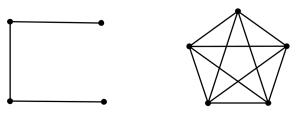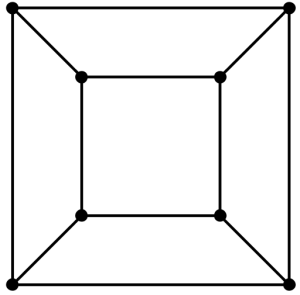 My day job combines teaching maths undergraduates, public communication of mathematics, and working with school students. When I'm not doing these things, I enjoy various forms of craft. I've recently been teaching myself to make beaded beads. So far, I've been concentrating on making the five Platonic solids, the regular polyhedra. These are highly symmetrical objects, and part of my teaching last year for the first-year Oxford maths undergraduates was about understanding the structure of the symmetries of these polyhedra (part of an area of maths called Group Theory).
My day job combines teaching maths undergraduates, public communication of mathematics, and working with school students. When I'm not doing these things, I enjoy various forms of craft. I've recently been teaching myself to make beaded beads. So far, I've been concentrating on making the five Platonic solids, the regular polyhedra. These are highly symmetrical objects, and part of my teaching last year for the first-year Oxford maths undergraduates was about understanding the structure of the symmetries of these polyhedra (part of an area of maths called Group Theory).
This summer I realised that my beading was closely connected to my teaching in another way too. I spent six weeks this summer helping to run a summer school, PROMYS Europe, in Oxford for exceptionally keen school-aged mathematicians. I chose to teach a course on one of my favourite areas of maths, namely Graph Theory.
In this context, a graph isn't something like a bar chart or a pie chart. Here, a graph is a collection of points, called vertices, some of which are connected by lines, called edges.  Graph Theory is a fascinating subject in its own right within pure mathematics, and also turns to have many real-world applications, such as to the delivery driver seeking to find the shortest route, or understanding network connectivity on the internet. The subject begain with Euler's solution of the problem of the bridges of Königsberg in the 1730s. The city of Königsberg had seven bridges spanning the rivers, and the problem was to determine whether it was possible for a resident of the city to go for a Sunday afternoon stroll that crossed every bridge just once (no doubling back). Euler recognised that the bridges and regions of land are not in themselves important, all that matters is the corresponding graph of vertices and edges. He was able to prove that the proposed walk crossing each bridge exactly once was impossible, by considering the number of edges out of each vertex. Every time our hypothetical rambler crosses a bridge to a different piece of land, she must then use a different bridge to leave, and so we need an even number of bridges from each landmass (even number of edges out of each vertex) -- and that is not the case with this configuration. I love that we can give a mathematical argument, a proof, of the impossibility. It's much more informative and satisfying than just trying all possible routes!
Graph Theory is a fascinating subject in its own right within pure mathematics, and also turns to have many real-world applications, such as to the delivery driver seeking to find the shortest route, or understanding network connectivity on the internet. The subject begain with Euler's solution of the problem of the bridges of Königsberg in the 1730s. The city of Königsberg had seven bridges spanning the rivers, and the problem was to determine whether it was possible for a resident of the city to go for a Sunday afternoon stroll that crossed every bridge just once (no doubling back). Euler recognised that the bridges and regions of land are not in themselves important, all that matters is the corresponding graph of vertices and edges. He was able to prove that the proposed walk crossing each bridge exactly once was impossible, by considering the number of edges out of each vertex. Every time our hypothetical rambler crosses a bridge to a different piece of land, she must then use a different bridge to leave, and so we need an even number of bridges from each landmass (even number of edges out of each vertex) -- and that is not the case with this configuration. I love that we can give a mathematical argument, a proof, of the impossibility. It's much more informative and satisfying than just trying all possible routes!
It turns o ut that this problem is relevant for my beading too. I'll illustrate this using the most familiar of the polyhedra, the cube. To add the turquoise beads, I have to work along each edge of the cube. It's wasteful of thread (and fiddly) to go along an edge twice, so ideally I'd just go along each edge exactly once. Is this possible? We can represent the three-dimensional cube by a two-dimensional graph.
ut that this problem is relevant for my beading too. I'll illustrate this using the most familiar of the polyhedra, the cube. To add the turquoise beads, I have to work along each edge of the cube. It's wasteful of thread (and fiddly) to go along an edge twice, so ideally I'd just go along each edge exactly once. Is this possible? We can represent the three-dimensional cube by a two-dimensional graph. And now Euler's argument tells us that we have no hope of passing along each edge exactly once, because there's an odd number of edges at every vertex! This is a little irritating for the beading, but at least I knew in advance and so didn't waste time trying to do the impossible!
And now Euler's argument tells us that we have no hope of passing along each edge exactly once, because there's an odd number of edges at every vertex! This is a little irritating for the beading, but at least I knew in advance and so didn't waste time trying to do the impossible!
Dr Vicky Neale
Former Fellow
References:
http://www.beadinfinitum.com/ -- website from which I got the beading instructions